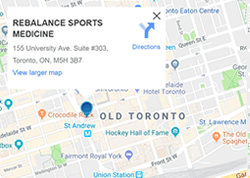Hip Labral Tears: Causes, Symptoms, Treatment and Exercises
 The labrum is a thick, fibrocartilaginous structure around the hip joint (acetabulum) that functions to deepen the socket, absorb shock, lubricate the joint and distribute pressure. Secondly, it also helps to provide ligamentous stability for the hip joint. When there is fraying or tears in the labrum, this often causes pain in the hip and groin and can cause the hip to feel “unstable”. As a result, pressure is more concentrated on the joints surfaces and can lead to early onset of osteoarthritis. An MRI is often required to determine if there is a tear, its severity and if surgery is indicated.
The labrum is a thick, fibrocartilaginous structure around the hip joint (acetabulum) that functions to deepen the socket, absorb shock, lubricate the joint and distribute pressure. Secondly, it also helps to provide ligamentous stability for the hip joint. When there is fraying or tears in the labrum, this often causes pain in the hip and groin and can cause the hip to feel “unstable”. As a result, pressure is more concentrated on the joints surfaces and can lead to early onset of osteoarthritis. An MRI is often required to determine if there is a tear, its severity and if surgery is indicated.
What Causes a Hip Labral Tear?
Labral tears often occur due to the following; high velocity trauma (MVA, falls, dislocations), Femoral acetabular impingement (FAI), degeneration of the joint over time due to repetitive loading. They are commonly seen in sports that involve repeated hip hyper extension, external rotation and twisting/ pivoting such as ballet, soccer, running and sprinting due to the repetitive stress on the hip joint over time.
The symptoms usually start as a dull ache in the front/side of the hip but can be sharp or “snap” in specific movements. In certain cases, the frayed ends of the labrum can get caught and pinched in the hip joint causing the hip to lock and spasm around the hip. As osteoarthritis progresses and wears down the joint cartilage, the labrum is more prone to wear and tear as it’s the ideal pressure distribution is compromised.
Physiotherapy, Chiropractic and Massage Therapy Treatment for a Hip Labral Tear?
The rehab team at Rebalance can assist with both conservatively managing the symptoms as well as post-arthroscopic surgery. The goals will be to reduce the pain by stretching the tight muscles at the front of the hip, mobilizing/stretch the hip joint to restore normal joint mechanics and strengthen muscle imbalances to increase stability at the hip. Core strength and balance may also be helpful to promote proper loading and mechanics at the hip.
What Should be Avoided with a Hip Labral Tear?
Positions of pain such as excessive hip extension, jumping and pivoting should be avoided as it can cause impingement of the hip joint and spasm of the surrounding musculature.
Safe Home Exercises for a Suspected Hip Labral Tear?
Once your pain has subsided you can start some range of motion exercises. A great option is on hand and knees and is called “4-point hip rocks”. In this position you slowly move your body weight forward and back over your hips. This will allow pressure and stretch on the joint in a controlled fashion and can be modified by adding internal or external hip rotation.
Often the hip flexors and other muscles at the front of the hip are tight and require stretching. The hip flexor lunge stretch is a comfortable stretch that can target both the hip flexors and quad muscles.
In most cases, the muscles at the back of the hip that are used to provide hip stability are often found to be weak. Glute bridge is a great exercise that can strengthen the whole posterior chain including the glutes and hamstring muscles.
How Long Does it Take to Recover From a Hip Labral Tear?
Through conservative management (physiotherapy/chiropractic), it can take 6-8 weeks to decrease the pain, increase the flexibility of tight muscles while strengthening weaker muscles to ensure the femur bone stays centered in the socket. For athletes, it may take an additional 2-4 weeks for sport specific exercises and progress balance, agility and speed training.
In some cases, depending on how large the tear is and if it causes locking at the hip, arthroscopic surgery may be required to remove large fragments, flatten the frayed edges or suture the labrum down. The recovery process will take about 12-16 weeks and will often have weight-bearing restrictions for 4 weeks requiring crutches for mobility immediately following surgery.
The first phase of recovery will focus on restoring the hip range of motion and gentle strengthening with isometric exercises. As the hip mobility improves, strengthening exercises can be progressed to more dynamic movements and work towards balance, agility and power by the end of the 16-week period similar to the conservative management with sport specific retraining.
For more information or if you suspect that you have a hip labral tear and would like professional guidance please book an assessment with one of Rebalance Sports Medicine Physiotherapists or Chiropractors for an individualized evaluation, prognosis and exercise program.
Helen Suen
Helen Suen is a registered physiotherapist practicing at Rebalance Sports Medicine in downtown Toronto.



 What to Expect From Your First Physiotherapy Visit
What to Expect From Your First Physiotherapy Visit The Benefits of Fascial Stretch Therapy [Demo]
The Benefits of Fascial Stretch Therapy [Demo] How Does Physiotherapy Work?
How Does Physiotherapy Work? Best Exercises for Low Back Pain
Best Exercises for Low Back Pain